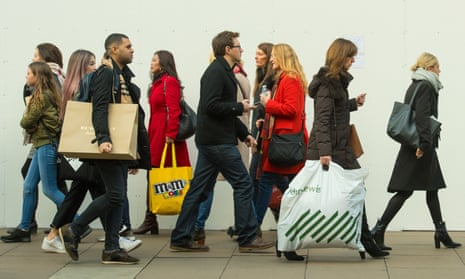The UK economy slowed even more sharply than first thought in the opening months of this year as rising prices in the wake of the Brexit vote took their toll on consumer spending.
The Office for National Statistics said GDP grew just 0.2% in the first quarter of 2017, a marked change of pace from the 0.7% growth in the final three months of 2016. Statisticians had previously estimated the economy grew 0.3% in the first quarter.
There was no growth at all in the first quarter in GDP per head, which adjusts for the size of the population and is generally seen as a better guide to prosperity than mere GDP.
The figures provide the latest evidence that the early resilience to the EU referendum result last June is now wearing off as higher inflation puts consumers under pressure. Prices have been picking up pace since the Brexit vote because it sent the pound sharply lower and has raised the cost of imports to the UK. That higher inflation has hit household budgets and dented the key driver of UK growth, consumer spending.
The ONS highlighted that pattern in its updated estimate of GDP growth on Thursday.
“UK GDP growth slowed to 0.2% in quarter one of 2017 as consumer-facing industries such as retail and accommodation fell and household spending slowed. This was partly due to rising prices,” it said in the data release.
“Construction and manufacturing also showed little growth, while business services and finance continued to grow strongly.”
Alan Clarke, an economist at Scotiabank in London, noted that first-quarter growth was below what the Bank of England and most City economists had been expecting.
“The outcome was in line with our forecast, but below the consensus expectation for 0.3% quarter-on-quarter and the BoE – in the fullness of time – expects the growth rate to be 0.4%,” he said.
“So this is disappointing and like driving down the motorway at 20mph instead of 70mph.”
The Bank said earlier this month that it expected GDP growth would edge up marginally to 1.9% for 2017 as a whole from growth of 1.8% in 2016. But it warned that living standards would fall this year because inflation would be higher than pay growth.
Kallum Pickering, economist at the bank Berenberg was among those commentators predicting growth would pick up again after the first-quarter lull.
“Should we be concerned? No, the dip is probably temporary,” he said.
“With both soft and hard data improving in the second quarter, the quarterly growth rate is likely to rebound to 0.4%.”
Ian Stewart, chief economist at the consultancy Deloitte was also optimistic the economy could continue expanding despite the pressure on household incomes.
“High inflation is hitting consumers, but a weak pound and a recovering global economy are helping businesses. UK growth is likely to tilt away from the consumer towards exports, manufacturing and investment this year. This should keep the UK economy growing at a similar rate to last year,” he said.
Ruth Gregory at Capital Economics said that given the discrepancy between the weak first quarter GDP data and upbeat surveys, there was “a good chance that the figure is revised back up in time”. She also noted quarterly 0.6% rise in business investment, “suggesting that Brexit uncertainty has not significantly weighed on firms’ spending plans”.
Gregory added: “We have not altered our view that the economy will remain fundamentally resilient in the coming quarters.”
Separate figures on housebuilding provided some reassurance on the outlook. The Department for Communities and Local Government said 43,170 new houses were started in England between January and March, up 3% on the previous quarter and up 21% on a year earlier. The number of completed houses rose to 39,520, about 9% higher than the previous quarter and 21% higher than a year ago.
Andy Frankish at the Mortgage Advice Bureau said: “The latest figures do indicate a marginal increase and we can see the signs of recovery starting in 2013, demonstrating the impact of the introduction of help to buy, which could suggest an element of cautious optimism that the industry has perhaps ‘turned the corner’ following the trough of 2009.
“But if we are to reach the 200,000-plus new-build homes needed each year in England, there is still more momentum required.”

Comments (…)
Sign in or create your Guardian account to join the discussion